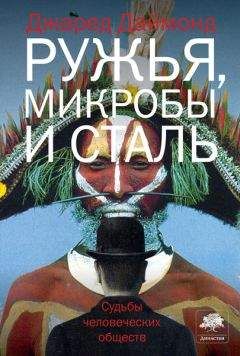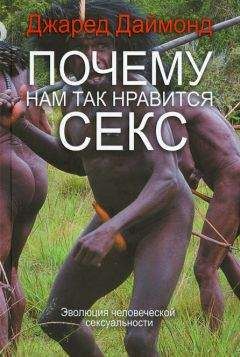Джаред Даймонд - Коллапс

Помощь проекту
Коллапс читать книгу онлайн
Три подробных рассказа о войнах между анасази и их соседями: Christy Turner II Jacqueline Turner. Man Corn: Cannibalism and Violence in the Prehistoric American Southwest. Salt Lake City: University of Utah Press, 1999;Steven LeBlanc. Prehistoric Warfare in the American Southwest. Salt Lake City: University of Utah Press, 1999;Jonathan Haas, Winifred Creamer. Stress and Warfare Among the Kayenta Anasazi of the Thirteenth Century a. d. Chicago: Field Museum of Natural History, 1993.
Монографии и ученые труды, посвященные специфическим проблемам или отдельным племенам и народностям юго-запада США: Paul Minnis. Social Adaptation to Food Stress: A Prehistoric Southwestern Example. Chicago: University of Chicago Press, 1985; W. H. Wills. Early Prehistoric Agriculture in the American Southwest. Santa Fe: School of American Research, 1988;R. Gwinn Vivian. The Chacoan Prehistory of the San Juan Basin. San Diego: Academic Press, 1990;Lynne Sebastian. The Chaco Anasazi: Sociopolitical Evolution and the Prehistoric Southwest. Cambridge: Cambridge University Press, 1992;Charles Redman. People of the Tonto Rim: Archaeological Discovery in Prehistoric Arizona. Washington, D. C.: Smithsonian Institution Press, 1993. О влиянии пересыхания русел каньона Чако можно прочитать в монографии: Eric Force, R. Gwinn Vivian, Thomas Wind.es, Jeffrey Dean. Relation of «Bonito» Paleo-channel and Base-level Variations to Anasazi Occupation, Chaco Canyon, New Mexico. Tuscon: Arizona State Museum, University of Arizona, 2002. Все, что вы захотите узнать о ямах Пэкрата, описано в книге: Julio Betancourt, Thomas Van Devender, Paul Martin. Packrat Middens. Tucson: University of Arizona Press, 1990.
Юго-запад также многократно становился темой многотомных научных сборников, среди них: New Light on Chaco Canyon / ed. David Grant Nobel. Santa Fe: School of American Research, 1984; George Gumerman, ed. The Anasazi in a Changing Environment. Cambridge: Cambridge University Press, 1988; Chaco and Hohokam: Prehistoric Regional Systems in the American Southwest / eds. Patricia Crown, W. James Judge. Santa Fe: School of American Research, 1991; Anasazi Regional Organization and the Chaco System / ed. David Doyel. Albuquerque: Maxwell Museum of Anthropology, 1992; The Prehistoric Pueblo World a. d. 1150–1350 / ed. Michael Adler. Tucson: University of Arizona Press, 1996; Great Towns and Regional Polities in the Prehistoric American Southwest and Southeast / ed. Jill Neitzel. Dragoon, Ariz.: Amerind Foundation, 1999; The Archaeology of Regional Interaction: Religion, Warfare, and Exchange Across the American Southwest and Beyond / ed. Michelle Hegmon. Boulder: University Press of Colorado, 2000; иMichael Diehl, Steven LeBlanc. Early Pithouse Villages of the Mimbres Valley and Beyond. Cambridge, Mass.: Peabody Museum of Archaeology and Ethnology, Harvard University, 2001.
Книги, которые я привел в этой библиографии — лишь основные вехи, позволяющие сориентироваться в научной литературе, посвященной юго-западу США. Но некоторые статьи, с которыми соотносится эта глава, я хочу упомянуть отдельно. Работы Хулио Бетанкура и его коллег о том, что мы узнали из исторической реконструкции растительности каньона Чако: Julio Betancourt, Thomas Van Devender. «Holocene vegetation in Chaco Canyon, New Mexico» // Science 214:656–658. 1981;Michael Samuels, Julio Betancourt. «Modeling the long-term effects of fuelwood harvests on pinyon-juniper woodlands» // Environmental Management 6:505–515. 1982; иJulio Betancourt, Jeffrey Dean, Herbert Hull. «Prehistoric long-distance transport of construction beams, Chaco Canyon, New Mexico» //American Antiquity 51:370–375. 1986. Две статьи о том, как менялось отношение анасази к дереву: Timothy Kohler, Meredith Matthews. «Long-term Anasazi land use and forest production: a case study of Southwest Colorado» // American Antiquity 53:537–564. 1988;Thomas Windes, Dabney Ford. «The Chaco wood project: the chronometric reappraisal of Pueblo Bonito» // American Antiquity 61:295–310. 1996. Уильям Булл дал в своей статье хороший обзор причин происхождения оврагов (W. Bull. «Discontinuous ephemeral streams» // Geomorphology 19:227–276.1997). Использованию изотопов стронция для изучения древесины и маиса из Чако посвящены две статьи: о древесине — Nathan English, Julio Betancourt, Jeffrey Dean, Jay Quade. «Strontium isotopes reveal distant sources of architectural timber in Chaco Canyon, New Mexico» // Proceedings of the National Academy of Sciences, USA 98:11891 — 11896. 2001; и о маисе — Larry Benson et al. «Ancient maize from Chacoan great houses: where was it grown?» // Proceedings of the National Academy of Sciences, USA 100:13111-13115. 2003. Экстелл с соавторами изучают взаимосвязь численности населения анасази с изменением сельскохозяйственного потенциала (R. L. Axtell et. all «Population growth and collapse in a multiagent model of the Kayenta Anasazi in Long House Valley» // Proceedings of the National Academy of Sciences, USA 99:7275–7279. 2002).
ГЛАВА 5Следующие недавно вышедшие книги представляют различные воззрения на коллапс цивилизации майя: David Webster. The Fall of the Ancient Maya. New York: Thames and Hudson, 2002;Richardson Gill. The Great Maya Droughts. Albuquerque: University of New Mexico Press, 2000; The Terminal Classic in the Maya Lowlands / eds. Arthur Demerest, Prudence Rice, Don Rice. Boulder: University Press of Colorado, 2004. Уэбстер приводит обзор истории майя и связывает исчезновение их цивилизации с несоответствием населения и ресурсов, в то время как Джилл заостряет внимание на климате, а Демерест придает основное значение комплексному воздействию причин и недооценивает экологическую интерпретацию. Ранее изданные сборники с различными оценками: The Classic Maya Collapse / ed. Т. Patrick Culbert. Albuquerque: University of New Mexico Press, 1973; Precolumbian Population History in the Maya Lowlands / eds. Т. Patrick Culbert, D. S. Rice. Albuquerque: University of New Mexico Press, 1990. Несколько глав, относящихся к теме майя, а также рассказ о других сообществах, таких как хохокам, андское и миссисипское содержится в: Imperfect Balance: Landscape Transformation in the Precolumbian Americas / ed. David Lentz. New York: Columbia University Press, 2000.
Книги о расцвете и упадке отдельных городов можно найти в: David Webster, Ann Corinne Freter, Nancy Gonlin. Copan: The Rise and Fall of an Ancient Maya Kingdom. Fort Worth: Harcourt Brace, 2000;Peter Harrison. The Lords of Tikal. New York: Thames and Hudson, 1999;Stephen Houston. Hieroglyphs and History at Dos Pilas. Austin: University of Texas Press, 1993;M. P. Dunning. Lords of the Hills: Ancient Maya Settlement in the Puuc Region, Yucatán, Mexico. Madison, Wis.: Prehistory Press, 1992. Из книг по общей истории майя читайте: Michael Сое. The Maya. 6th ed. New York: Thames and Hudson, 1999;Simon Martin, Nikolai Grube. Chronicle of the Maya Kings and Queens. New York: Thames and Hudson, 2000; Robert Sharer. The Ancient Maya. Stanford, Calif.: Stanford University Press, 1994;Linda Scheie, David Freidel. A Forest of Kings. New York: William Morrow, 1990;Linda Scheie, Mary Miller. The Blood of Kings. New York: Braziller, 1986.
Вот две классические книги Джона Стивенса, описывающие повторные открытия: JohnStephens. Incidents of Travel in Central America, Chiapas and Yucatan. New York: Harper, 1841;John Stephens. Incidents of Travel in Yucatan. New York: Harper, 1843. A о Джоне Стивенсе, его жизни и открытиях можно прочитать в книге Виктора Вольфганга фон Хагена (VictorWolfgangvonHagen. Maya Explorer. Norman: University of Oklahoma Press, 1948).
Существует множество работ, обсуждающих рост населения майя и интенсивность их сельского хозяйства, среди них: В. L. TurnerИ. «Prehistoric intensive agriculture in the Mayan lowlands» // Science 185:118–124. 1974;B. L. Turner II, Peter Harrison. «Prehistoric raised-field agriculture in the Maya lowlands» // Science 213:399–405. 1981; B. L. Turner II, Peter Harrison. Pull-trouser Swamp: Ancient Maya Habitat, Agriculture, and Settlement in Northern Belize. Austin: University of Texas Press, 1983;Thomas Whitmore, B. L. Turner II. «Landscapes of cultivation in Mesoamerica on the eve of the conquest» // Annals of the Association of American Geographers 82:402–425. 1992; В. L. Turner II, К. W. Butzer. «The Columbian encounter and land-use change» // Environment 43:16–20; 37–44. 1992.
Свежие статьи, подробно описывающие результаты изучения водоемов майя, имевшие большое значение для их цивилизации: Mark Brenner et al. «Paleolimnology of the Maya lowlands: long-term perspectives on interactions among climate, environment, and humans» // Ancient Mesoamerica 13:141–157. 2002; (см. также статьи на страницах. 79-170 и 265–345 того же сборника);David Ноdell et al. «Solar forcing of drought frequency in the Maya lowlands» // Science 292:1367–1370. 2001;Jason Curtis et al. «Climate variability of the Yucatan Peninsula (Mexico) during the past 3500 years, and implications for Maya cultural evolution» // Quaternary Research 46:37–47. 1996;David Hodeli et al. «Possible role of climate in the collapse of Classic Maya civilization» // Nature 375: 391–394. 1995. Две статьи той же группы ученых, посвященные пересыханию прудов в районе Петен: Michael Rosenmeier, «А 4000-year lacustrine record of environmental change in the southern Maya lowlands, Peten, Guatemala» // Quaternary Research 57:183–190. 2002;иJason Curtis et al. «А multiproxy study of Holocene environmental change in the Maya lowlands of Peten, Guatemala» // Journal of Paleolimnology 19:139–159. 1998. Исследование озерных отложений год за годом смываемых в океан реками рассмотрено в следующей статье: Gerald Haug et al. «Climate and the collapse of Maya civilization» // Science 299:1731–1735. 2003.
Если вы интересуетесь темой майя, не пропустите книгу М. Э. Миллер о настенной живописи индейцев (Mary Ellen Miller. The Murals of Bonampak. Princeton, N.J.: Princeton University Press, 1986) с прекрасными иллюстрациями, как цветными, так и черно-белыми репродукциями настенных изображений с жуткими сценами пыток, а также многотомное собрание репродукций керамики майя Ж. Керр (Justin Kerr. The Maya Vase Book. New York: Kerr Associates, various dates). Захватывающая история о том, как была расшифрована письменность майя, хорошо освещена в книгах: Michael Сое. Breaking the Maya Code. 2nd ed. New York: Thames and Hudson, 1999;Stephen Houston, Oswaldo Chinchilla Mazareigos, David Stuart. The Decipherment of Ancient Maya Writing. Norman: University of Oklahoma, 2001. Описание резервуаров Тикаля: Vernon Scarborough, Gari Gallopin. «А water storage adaptation in the Maya lowlands» // Science 251:658–662. 1991. Статья Л. Люцеpo (Lisa Lucero. «The collapse of the Classic Maya: a case for the role of water control» // American Anthropologist. 104:814–826. 2002) поясняет, почему проблемы с водой в разных местах могли привести к различным типам гибели и разные города постигла разная участь. Следующая работа (Arturo Gómez-Pompa, José Salvador Flores, Victoria Sosa. «The „pet kot“: a man-made tropical forest of the Maya» // Interciencia 12:10–15. 1987) описывает, как майя возделывали участки леса с полезными деревьями. Тимоти Бич (Timothy Beach. «Soil catenas, tropical deforestation, and ancient and contemporary soil erosion in the Petén, Guatemala» // Physical Geography 19:378–405/ 1998) показывает, что в некоторых областях, хотя и не везде, майя справлялись с эрозией почвы с помощью террасирования. Работа Ричарда Хансена с сотр. (Richard Hansen et al. «Climatic and environmental variability in the rise of Maya civilization: a preliminary perspective from northern Petén» // Ancient Meso-america 13:273–295.2002) представляет многостороннее изучение плотно населенного в доклассическую эпоху ареала и приводит доказательства того, что производство строительного раствора явилось движущей силой процесса гибели лесов.

























